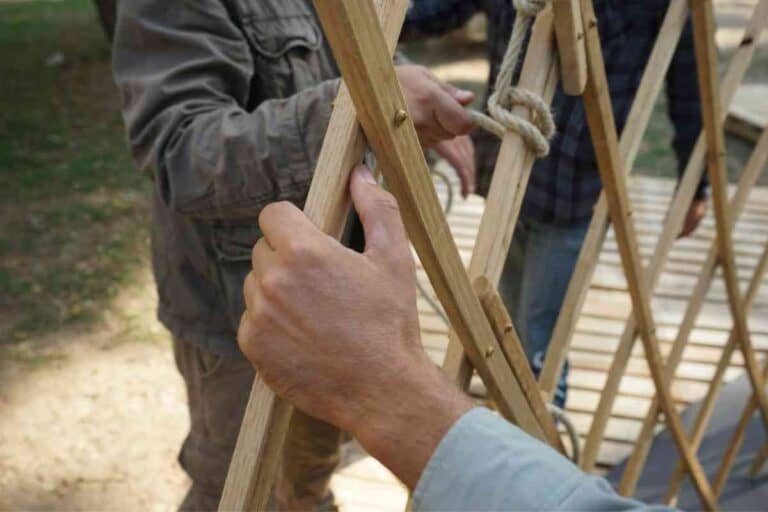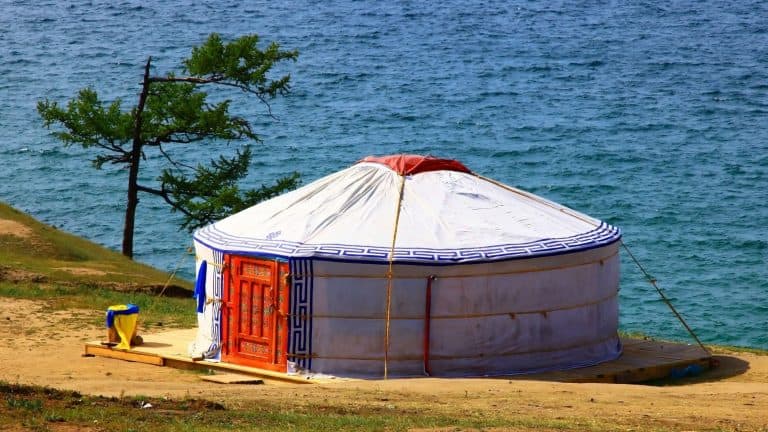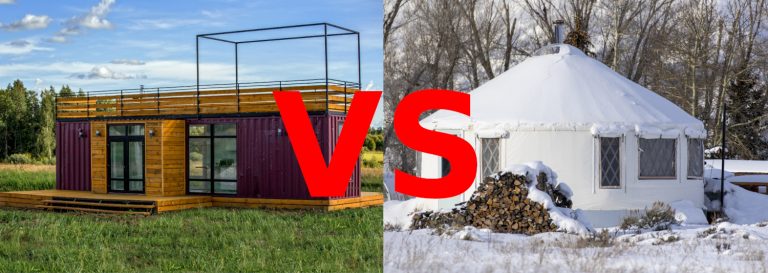How Long Does It Take to Build a Yurt?
Yurt living is a great way to live frugally and mortgage-free or just as an affordable vacation home. You can buy a high-quality yurt of decent size for about $12,000 or less. And unlike most other structures, yurts are very easy and quick to build, even without prior construction experience.
A small yurt kit can be set up in a matter of hours, while a large yurt can be built on a weekend. Making a yurt from scratch will take significantly longer and depend on your woodworking skills. Add time to lay utility pipes and cables if needed.
In this article, we will go through what it takes to build a yurt of any size and what you should consider when planning your build.
Time Factors
Before we go into details of the process itself, we should consider the factors that affect how long it will take to set up a yurt:
Climate and Weather
In cold climates where you need more insulation, the process may take a little longer. Not only do you need to use heavier covers, but it will also take some time to add additional insulation batts.
The weather will also influence how long it takes to build a yurt. I recommend you build it during summer and in clear weather. Wind will make it much more difficult to pull the cover over the yurt, and rain or snow will cause humidity (leading to potential mildew issues) inside the yurt and between the layers of fabric.
Location
The location of your yurt will impact how easy or difficult it will be to have your materials delivered. Most people do not build their yurt from scratch but buy a kit that only has to be assembled. But as yurts are not very common outside of central Asia, there are not that many yurt manufacturers or resellers. Meaning you may not live close to one.
Yurts do weigh quite a bit (around 500 to 3,000 pounds, depending on size and materials used) and will usually be delivered by truck. If the destination is inaccessible by truck, you may have to go back and forward several times in a smaller vehicle.
A related factor is how cooperative your local authorities are in regards to permits. While some states and counties have very few regulations, others will make you jump through hoops and hurdles to set up a yurt legally. Red tape can be frustrating and very time-consuming.
Yurt Size
A tiny yurt made for one or two people can be set up in a very short time. Possibly just a few hours. A large yurt takes a bit longer. This is mainly because there will be many more rafters to attach, but also because it is harder to pull the covers over a tall yurt. Yurts 30 feet in diameter and above will need machine lifting due to the weight of the fabric.
Setting up a 40-foot yurt will not take twice as long as a 20-foot yurt. Most of the steps are the same or slightly more demanding.
How Many Builders?
Setting up a yurt can be a social thing, but just a few people can also do it. There is no need for specialized builders or heavy machinery (or any machinery at all), and one person can theoretically do it. However, it will be easier for two.
If it is a large (communal?) yurt, being a bigger group of builders will significantly speed up adding rafters and tying them to the lattice walls. Although, pulling the covers over the yurt is still just a two or three-man job.
Platform, Foundation, or Right on the Ground
You can place a yurt directly on the ground, which is a good solution if you plan on moving it often. But if your yurt is intended as a permanent structure, it is highly recommended to place it on a foundation or a wooden platform. This will make the yurt last longer and provide insulation from below.
Building a platform or a foundation is somewhat time-consuming. How time-consuming depends on your construction skills and how it is made, but it will take some time to do. In fact, this may take longer than setting up the yurt itself, and you should expect to spend at least a couple of days when building a sturdy wooden platform.
Permits and Paperwork
You may need a permit to set up a yurt on your property. As yurts are sometimes considered tents, other times permanent structures, this will depend on your location.
In some places getting the right permit (or even getting an answer to whether you need one) can be challenging. Yurts are relatively uncommon outside Mongolia, and a few other Asian countries, meaning your local zoning regulations and building codes may not provide clear answers.
You may have to spend some time arguing your case, going over regulations, and talking to experts. Start by contacting your county clerk and ask how they recommend you approach the matter.
Preparing the Yurt
If you plan on building your yurt from scratch, you will need several materials:
- lumber (wooden stips and rafters) to make walls, roof, roof wheel, and door
- fabric and sewing equipment to make covers
- insulation materials (read more here)
- rope and ratchet tie down straps to keep it all together
Making a yurt from scratch is not as easy as it may look. It can be done, but having prior woodworking experience will be very beneficial.
A much easier solution is to buy a kit from a trusted manufacturer. You will probably have to pay more for a kit than if you made it yourself, but you will also save a lot of time. Cutting and shaping the rafters and assembling the lattice walls and the roof wheel would take a while, whereas a kit is fully prepared and much faster to set up.
Setting up the Yurt
Setting up a yurt is very quick compared to most other structures. You do not need any construction skills, and there are no tools involved, except for larger yurts which need machines to lift the cover. Essentially, the process of building a yurt consists of these five steps:
- Set up and connect the lattice walls and the door
- Lift up the roof wheel
- Attach roof rafters to the roof wheel and the walls
- Pull the covers over the structure
- Tie a rope around the cover to keep it from moving or falling off
This process will usually take from a few hours to a day, depending on its size. If you use modern materials, like glass pane windows, the process will take longer. If you need to add insulation in addition to the felt cover (often recommended), this will also take some time. The entire process should not take much longer than two days unless you have a very large yurt.
It is possible to set up a yurt by yourself, although it is recommended to be at least two people. Doing it yourself will take significantly longer, but one person can do all parts of the process. Watch this video on how it is done.
Adding a wood stove and chimney pipe should not take more than an hour. If you need modern amenities, such as electricity and running water, include that in your schedule. How long this takes will depend on factors, such as distance to municipal facilities and digging conditions.
In Short
Compared to most other building projects, yurts are not only affordable, but they are also very quick and easy to set up. Unless you have very specialized requirements, it should not take more than a weekend before you have a dry and comfortable home that will last you for years.





![Are Yurts Good For Hot Weather? [4 Tips To Stay Cool!]](https://freedomresidence.com/wp-content/uploads/2022/05/Can-You-Live-in-a-Yurt-Year-Round-2-768x512.jpg)
![Can I Live In A Yurt On My Own Land? [Answered!]](https://freedomresidence.com/wp-content/uploads/2022/05/Can-You-Live-in-a-Yurt-On-Your-Own-Land-1-768x512.jpg)